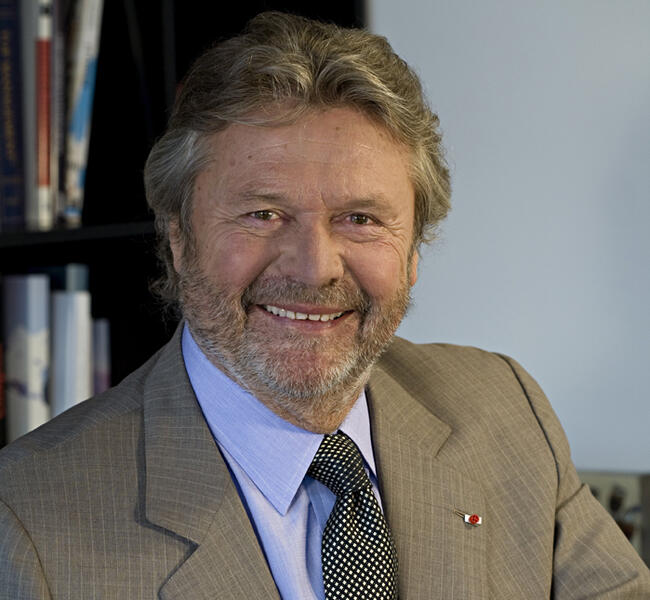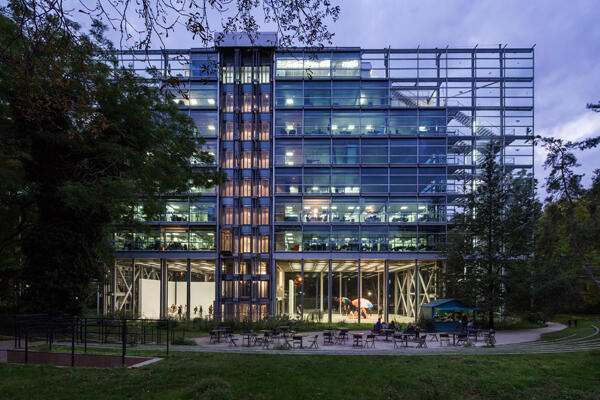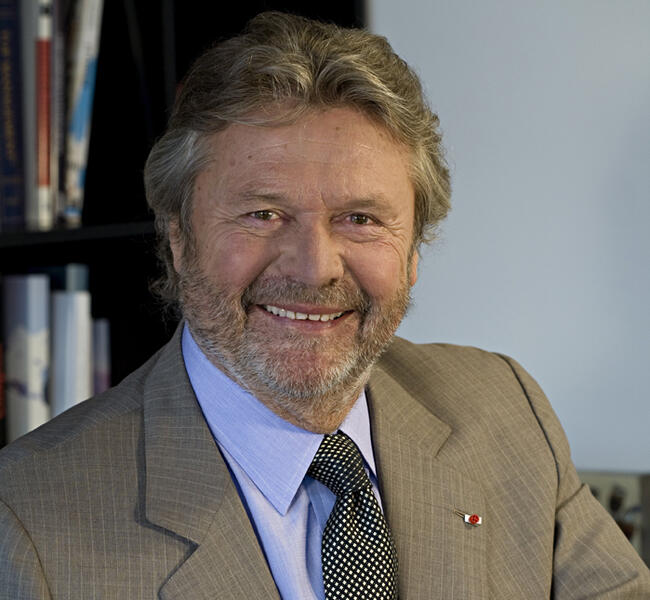_Vivid Memories 1984-2014_
Conversations with Alain Dominique Perrin and Hervé Chandès
The Fondation Cartier pour l’art contemporain - PARIS

Figures and Names
“1400 artists exhibited, 150 in France and 82 abroad, 1300 works in the permanent collection. That is what 30 years of the Fondation Cartier represent”, Alain Dominique Perrin, president of the Fondation, points out in his speech on the opening day of the exhibition Vivid Memories, which celebrates the mentioned institution’s anniversary. Immediately after this enumeration of facts, he insists on reminding us of the full name of the institution, highlighting its mission and origin: Fondation Cartier pour l’art contemporain. “It is not only its name, but also its commitment”. And thanking at the same time the French artist César, for without him, the concept of the Fondation would not have seen the light.
Founded in Paris in the mid19th century, the Cartier Society, as it is known, is a company in the luxury goods sector that designs, manufactures and sells jewelry and watches. Unlike other French foundations, the Fondation Cartier pour l’art contemporain is proud of being the only foundation that clearly separates any business activities from those of the foundation itself. In other words, Cartier does not request any artist to create marketable products. And that determination has been very clear to them since the creation of the Fondation, the first in the history of France[1].
Ten months of festivities to commemorate the anniversary
To celebrate its 30th anniversary, the Fondation Cartier offered to the public, until the end of September, the best selection of works from its collection. Vivid Memories was an exhibition in constant movement. The works were rotated; every month, visitors could see new works ranging from pieces by Nan Goldin to works by Raymond Depardon o Issey Miyake. There were performances, concerts, seminars, and so on. The program was very varied and encouraging. The exhibition gathered together the community of artists with which the Fondation Cartier has built and continues to create its history, highlighting the strong bonds it maintains with artists.
Its History
It is narrated to us by Hervé Chandès – the director of the Fondation for the past 20 years – from that tall and transparent laboratory of ideas between heaven and earth that is his office, located on the top floor of the building designed by Nouvel. The first venue occupied a very large and beautiful space in the outskirts of Paris, in Jouy-en-Josas, he points out. There were numerous artists’ workshops, residency programs, without any obligation of obtaining specific results. Several exhibitions were organized. It was also a space for meetings. The Fondation permanently hosted five or six artists from all over the world, among them, Fabrice Hybert, Othoniel, Chéri Samba, and Quai Guo-Quiang. We were also visited by art critics like Hans Ulrich Obricht or Nancy Spector. In 1993, we left Jouy-en-Josas to settle in the heart of Paris, 261, Boulevard Raspail, in a 1,000 square-meter building especially designed by the monumental Jean Nouvel. In the words of the foundation’s president, Alain Perrin: “The architect enveloped the Fondation in an image of beauty, transparency, and visual and artistic perfection, transforming it into a Parisian monument, indelible and eternal.”
Hervé Chandès highlights the institution’s founding ideas. Since its creation in 1984, the Fondation has sponsored creation and artists, funding special commissions from the latter. And “if there no longer are workshops in the Paris venue, it’s because we did not wish to have them. The workshops were replaced by an increase in commissions from artists, and sometimes a whole exhibition is the commission. Here we only buy what we show”.
The game is to exhibit rock’n’roll, and the next day popular art
The bases and principles that have ruled the organization until now were developed from the very beginning. They include a cross-cutting approach and an international dimension. Immediately after the creation of the foundation, design imposed itself through the work of Philippe Starck, Pascal Mourgue, Elizabeth Garouste, Matias Bonetti, Nestor Perkal and many others. At that time, Chandès insists, “it was not very fortunate to incorporate design in a contemporary art space, and this was confirmed by the press”. It was new and innovative. Then the devil came into the house with Ferrari’s exhibition. As in cascade mode, Chandès continues to illustrate the cross-cutting approach in question and the heteroclite nature of the foundation’s historical programming: an exhibition on speed was organized twenty-five years ago; the space hosted the fashion designers André Courrèges and Jean-Paul Gaultier, who transformed the foundation’s exhibition space into…a bakery, no less! Cinema became installed in the exhibition halls via the work of Agnès Varda or David Lynch. At that moment, a wholly new relationship between the filmed space and the exhibition space was invented. There were no exhibitions on science; rather, there were exhibitions with scientists ( Mathematics, 2011). Performing arts and performances also had an important role, as did photography, video, folk art, comics, etc. Music has also occupied a very special place: suffice it to mention the famous concert by the Blue Velvet.
The program of Vivid Memories, which included artists from around the world, gave evidence of the importance assigned to the international dimension, which became consolidated as a fundamental axis from the beginning, since the days of Jouy-en-Josas, as demonstrated by the presence of Chinese artists. Quite unusual at that time.
The preceding exhibition, for instance, had focused its gaze on the photographic production of the Latin American continent. Hervé Chandès explained to us how the idea behind the exhibition América Latina, 1960-2013, Fotografías (Latin America 1960-2013. Photography) had originated: ”Well, it’s very simple. I have been visiting Latin America for years, especially Brazil, sometimes Argentina, and less frequently, Chile. I met people, I attended exhibitions, I consulted books, and with time, I realized there was a world of photography there that we ignored. And besides, photography is currently a rising trend. Then one day, we simply reached the decision of organizing this exhibition together with the Museo Amparo.”
“Our interest in Latin America originates, on the one hand, in our curiosity regarding what is foreign. We have always been concerned with not remaining confined to Europe. It is a sort of survival instinct. On the other hand, since 1985, Gilberto Châteaubriand, a great Brazilian collector, has been a member of the Foundation’s Collection Committee. With him I discovered Latin America for the first time. Thanks to him I understood how extraordinary that culture was; he was the one who familiarized me with all the artists, from Waltercio Caldas to Ernesto Neto; from Adriana Varejão to Beatriz Milhazes or Brazilian folk art; we trod a path together through which our interest in that wonderful region was forged”.
Currently, the director tells us, the Foundation’s collection includes works by Adriana Varejão, mainly linked to the two exhibitions she has presented at the Foundation, an individual one, and one with the Yanomami Indians. Works by Guillermo Kuitka, or by Alair Gómez – pieces of Paraguayan folk art – unknown to most people, are also part of the collection.
“We always try to find our position; we try to see what our neighbor is doing so that we can do something different. We always have that concern in mind: to do something which has never been done. We would never have organized the exhibition on Latin American photography if it had been done before. Because staging an exhibition implies a commitment; a commitment with something you yourself have discovered. It’s not about saying ‘we have finished with Brazil, let’s go visit Australia’. No; we are not predators; it’s not the style of this house”.
The idea is that the perspective for the future of the Cartier Foundation remain the same: to continue maintaining privileged relationships with the artists: to continue fostering exchanges, looking outward and giving rise to prolific encounters with innovative exhibitions.
A single piece of advice: continue along the same path!
[1] The Fondation Cartier received the honorable commission to draft the law on business patronage of the arts, voted in July, 1987. At the beginning of July of that same year, it was awarded the “Coup de Chapeau” of the Oscars of patronage, a contest organized by the Admical association to highlight patronage policies that were exemplary for their innovative, sustainable and ethic dimensions.







